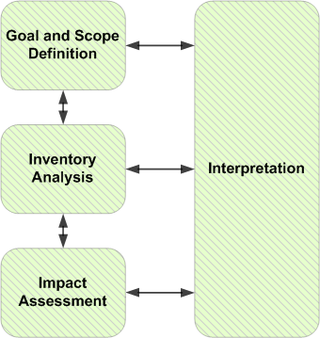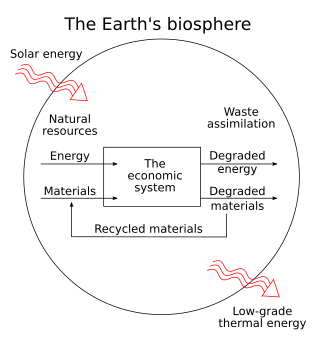A resistor–capacitor circuit, or RC filter or RC network, is an electric circuit composed of resistors and capacitors. It may be driven by a voltage or current source and these will produce different responses. A first order RC circuit is composed of one resistor and one capacitor and is the simplest type of RC circuit.

In economics, a production function gives the technological relation between quantities of physical inputs and quantities of output of goods. The production function is one of the key concepts of mainstream neoclassical theories, used to define marginal product and to distinguish allocative efficiency, a key focus of economics. One important purpose of the production function is to address allocative efficiency in the use of factor inputs in production and the resulting distribution of income to those factors, while abstracting away from the technological problems of achieving technical efficiency, as an engineer or professional manager might understand it.

Life cycle assessment or LCA is a methodology for assessing environmental impacts associated with all the stages of the life cycle of a commercial product, process, or service. For instance, in the case of a manufactured product, environmental impacts are assessed from raw material extraction and processing (cradle), through the product's manufacture, distribution and use, to the recycling or final disposal of the materials composing it (grave).
Sensitivity analysis is the study of how the uncertainty in the output of a mathematical model or system can be divided and allocated to different sources of uncertainty in its inputs. A related practice is uncertainty analysis, which has a greater focus on uncertainty quantification and propagation of uncertainty; ideally, uncertainty and sensitivity analysis should be run in tandem.
Howard Thomas Odum, usually cited as H. T. Odum, was an American ecologist. He is known for his pioneering work on ecosystem ecology, and for his provocative proposals for additional laws of thermodynamics, informed by his work on general systems theory.
In thermodynamics, the exergy of a system is the maximum useful work possible during a process that brings the system into equilibrium with a heat reservoir, reaching maximum entropy. When the surroundings are the reservoir, exergy is the potential of a system to cause a change as it achieves equilibrium with its environment. Exergy is the energy that is available to be used. After the system and surroundings reach equilibrium, the exergy is zero. Determining exergy was also the first goal of thermodynamics. The term "exergy" was coined in 1956 by Zoran Rant (1904–1972) by using the Greek ex and ergon meaning "from work", but the concept had been earlier developed by J Willard Gibbs in 1873.
In energy economics and ecological energetics, energy return on investment (EROI), also sometimes called energy returned on energy invested (ERoEI), is the ratio of the amount of usable energy delivered from a particular energy resource to the amount of exergy used to obtain that energy resource.

Embodied energy is the sum of all the energy required to produce any goods or services, considered as if that energy was incorporated or 'embodied' in the product itself. The concept can be useful in determining the effectiveness of energy-producing or energy saving devices, or the "real" replacement cost of a building, and, because energy-inputs usually entail greenhouse gas emissions, in deciding whether a product contributes to or mitigates global warming. One fundamental purpose for measuring this quantity is to compare the amount of energy produced or saved by the product in question to the amount of energy consumed in producing it.

Ecological engineering uses ecology and engineering to predict, design, construct or restore, and manage ecosystems that integrate "human society with its natural environment for the benefit of both".
Emergy is the amount of energy consumed in direct and indirect transformations to make a product or service. Emergy is a measure of quality differences between different forms of energy. Emergy is an expression of all the energy used in the work processes that generate a product or service in units of one type of energy. Emergy is measured in units of emjoules, a unit referring to the available energy consumed in transformations. Emergy accounts for different forms of energy and resources Each form is generated by transformation processes in nature and each has a different ability to support work in natural and in human systems. The recognition of these quality differences is a key concept.
The Energy Systems Language, also referred to as Energese, Energy Circuit Language, or Generic Systems Symbols, is a modelling language used for composing energy flow diagrams in the field of systems ecology. It was developed by Howard T. Odum and colleagues in the 1950s during studies of the tropical forests funded by the United States Atomic Energy Commission.

Systems ecology is an interdisciplinary field of ecology, a subset of Earth system science, that takes a holistic approach to the study of ecological systems, especially ecosystems. Systems ecology can be seen as an application of general systems theory to ecology. Central to the systems ecology approach is the idea that an ecosystem is a complex system exhibiting emergent properties. Systems ecology focuses on interactions and transactions within and between biological and ecological systems, and is especially concerned with the way the functioning of ecosystems can be influenced by human interventions. It uses and extends concepts from thermodynamics and develops other macroscopic descriptions of complex systems.

Energy quality is a measure of the ease with which a form of energy can be converted to useful work or to another form of energy: i.e. its content of thermodynamic free energy. A high quality form of energy has a high content of thermodynamic free energy, and therefore a high proportion of it can be converted to work; whereas with low quality forms of energy, only a small proportion can be converted to work, and the remainder is dissipated as heat. The concept of energy quality is also used in ecology, where it is used to track the flow of energy between different trophic levels in a food chain and in thermoeconomics, where it is used as a measure of economic output per unit of energy. Methods of evaluating energy quality often involve developing a ranking of energy qualities in hierarchical order.
Exergy efficiency computes the effectiveness of a system relative to its performance in reversible conditions. It is defined as the ratio of the thermal efficiency of an actual system compared to an idealized or reversible version of the system for heat engines. It can also be described as the ratio of the useful work output of the system to the reversible work output for work-consuming systems. For refrigerators and heat pumps, it is the ratio of the actual COP and reversible COP.

The maximum power principle or Lotka's principle has been proposed as the fourth principle of energetics in open system thermodynamics, where an example of an open system is a biological cell. According to Howard T. Odum, "The maximum power principle can be stated: During self-organization, system designs develop and prevail that maximize power intake, energy transformation, and those uses that reinforce production and efficiency."
David M. Scienceman is an Australian scientist; he changed his name from David Slade by deed poll in 1972. McGhee (1990) wrote that his change of name from Slade to Scienceman was an experiment to create a movement of scientifically aware politicians. In a world dominated by scientific achievements and problems, Slade believed that there should be a political party that represented the scientific point of view.
James J. Kay was an ecological scientist and policy-maker. He was a respected physicist best known for his theoretical work on complexity and thermodynamics.
Sustainability metrics and indices are measures of sustainability, and attempt to quantify beyond the generic concept. Though there are disagreements among those from different disciplines, these disciplines and international organizations have each offered measures or indicators of how to measure the concept.
An economic input-output life-cycle assessment, or EIO-LCA involves the use of aggregate sector-level data to quantify the amount of environmental impact that can be directly attributed to each sector of the economy and how much each sector purchases from other sectors in producing its output. Combining such data sets can enable accounting for long chains, which somewhat alleviates the scoping problem of traditional life-cycle assessments. EIO-LCA analysis traces out the various economic transactions, resource requirements and environmental emissions required for producing a particular product or service.

Vibration is a mechanical phenomenon whereby oscillations occur about an equilibrium point. The word comes from Latin vibrationem. The oscillations may be periodic, such as the motion of a pendulum—or random, such as the movement of a tire on a gravel road.














